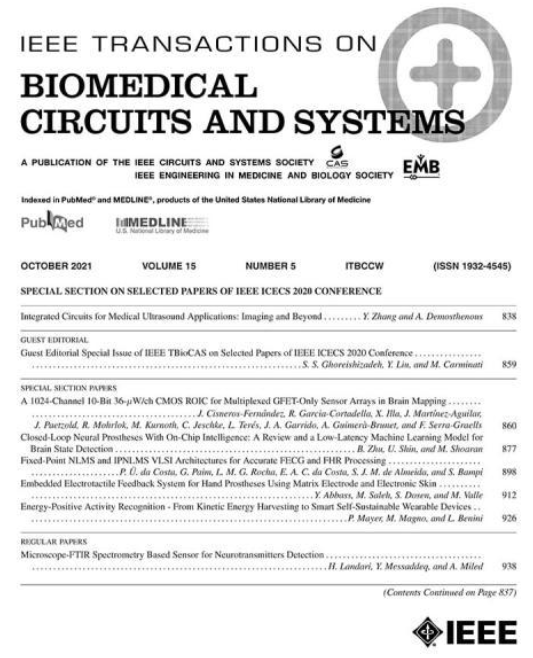用于光遗传视网膜假体和平面神经刺激的高密度、高亮度μLED基质
IF 4.9
2区 医学
Q2 ENGINEERING, BIOMEDICAL
IEEE Transactions on Biomedical Circuits and Systems
Pub Date : 1900-01-01
DOI:10.1109/TBCAS.2016.2623949
引用次数: 27
摘要
光学神经元刺激阵列在体外生物学和视网膜修复生物医学应用中都很重要。因此,在这项工作中,我们提出了一个8100像素的高辐射光子刺激器。该芯片模块垂直结合了定制的氮化镓μ led和CMOS应用专用集成电路。这是设计与活动像素,以确保随机访问,并允许所有需要的像素连续照明。μ led已使用焊料球倒装芯片键合技术组装在芯片上,从而实现可靠和可重复的制造。我们通过测量不同的因素来评估矩阵的性能,包括静态、动态功耗、照度和每个LED的电流消耗。我们表明,功耗在适合便携式使用的范围内。最后,对基体的热行为进行了监测,证明了该基体是热稳定的。本文章由计算机程序翻译,如有差异,请以英文原文为准。
High density, high radiance μLED matrix for optogenetic retinal prostheses and planar neural stimulation
Optical neuron stimulation arrays are important for both in-vitro biology and retinal prosthetic biomedical applications. Hence, in this work, we present an 8100 pixel high radiance photonic stimulator. The chip module vertically combines custom made gallium nitride μLEDs with a CMOS application specific integrated circuit. This is designed with active pixels to ensure random access and to allow continuous illumination of all required pixels. The μLEDs have been assembled on the chip using a solder ball flip-chip bonding technique which has allowed for reliable and repeatable manufacture. We have evaluated the performance of the matrix by measuring the different factors including the static, dynamic power consumption, the illumination, and the current consumption by each LED. We show that the power consumption is within a range suitable for portable use. Finally, the thermal behavior of the matrix is monitored and the matrix proved to be thermally stable.
求助全文
通过发布文献求助,成功后即可免费获取论文全文。
去求助
来源期刊

IEEE Transactions on Biomedical Circuits and Systems
工程技术-工程:电子与电气
CiteScore
10.00
自引率
13.70%
发文量
174
审稿时长
3 months
期刊介绍:
The IEEE Transactions on Biomedical Circuits and Systems addresses areas at the crossroads of Circuits and Systems and Life Sciences. The main emphasis is on microelectronic issues in a wide range of applications found in life sciences, physical sciences and engineering. The primary goal of the journal is to bridge the unique scientific and technical activities of the Circuits and Systems Society to a wide variety of related areas such as: • Bioelectronics • Implantable and wearable electronics like cochlear and retinal prosthesis, motor control, etc. • Biotechnology sensor circuits, integrated systems, and networks • Micropower imaging technology • BioMEMS • Lab-on-chip Bio-nanotechnology • Organic Semiconductors • Biomedical Engineering • Genomics and Proteomics • Neuromorphic Engineering • Smart sensors • Low power micro- and nanoelectronics • Mixed-mode system-on-chip • Wireless technology • Gene circuits and molecular circuits • System biology • Brain science and engineering: such as neuro-informatics, neural prosthesis, cognitive engineering, brain computer interface • Healthcare: information technology for biomedical, epidemiology, and other related life science applications. General, theoretical, and application-oriented papers in the abovementioned technical areas with a Circuits and Systems perspective are encouraged to publish in TBioCAS. Of special interest are biomedical-oriented papers with a Circuits and Systems angle.
 求助内容:
求助内容: 应助结果提醒方式:
应助结果提醒方式:


